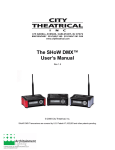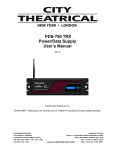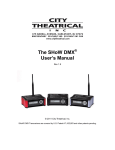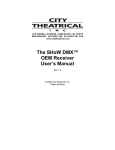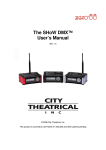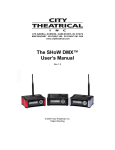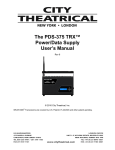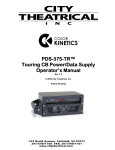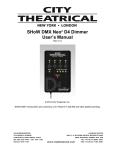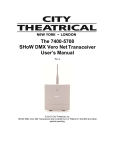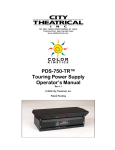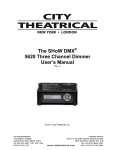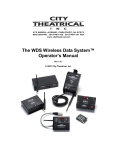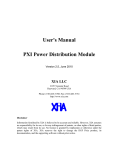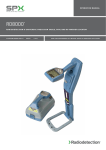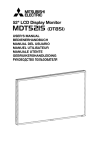Download The MasterBlast™ User`s Manual
Transcript
The MasterBlast™ User’s Manual Rev 1.8 © 2008 City Theatrical, Inc. SHoW DMX® Transceivers are covered by U.S. Patent # 7,432,803 and other patents pending. 2 Contents Figures .........................................................................................................................................3 Tables...........................................................................................................................................3 Safety Notices .............................................................................................................................3 Introduction .................................................................................................................................4 CHAPTER 1, BASICS ..................................................................................................................4 Quick Start Guide........................................................................................................................5 CHAPTER 2, SETUP....................................................................................................................6 Assembling the MasterBlast Kit ..............................................................................................6 Connecting the MasterBlast to a Wired DMX Device .............................................................7 Color Kinetics CKDMX Output Pinout.....................................................................................7 Using the “Aux Power In” power input ....................................................................................7 CB Output Fuse ......................................................................................................................7 CHAPTER 3, OPERATING THE MASTERBLAST ......................................................................8 User Interface .........................................................................................................................8 The Routines Menu.................................................................................................................8 Color Wash EB ......................................................................................................................9 Color Wash ............................................................................................................................9 Cross Fade ............................................................................................................................9 Color Wave 6 Light ................................................................................................................9 Color Wave 12 Light ............................................................................................................10 Color Wave 18 Light ............................................................................................................10 Random Color......................................................................................................................10 Random Fade ......................................................................................................................10 Fixed Color ..........................................................................................................................11 Receive SHoW DMX ...........................................................................................................11 The Settings Menu................................................................................................................11 Grand Master.......................................................................................................................11 SHoW ID..............................................................................................................................11 Power...................................................................................................................................13 Panel Lockout ......................................................................................................................13 Backlight Time Out ..............................................................................................................13 RDM.....................................................................................................................................13 Firmware..............................................................................................................................13 miniZapi ...............................................................................................................................13 Restore Default?..................................................................................................................14 CHAPTER 4, THE CTI BATTERY BASE...................................................................................15 Features................................................................................................................................15 Charging and Discharging ....................................................................................................15 APPENDIX A: TYPICAL SYSTEM EXAMPLE DRAWINGS ....................................................17 APPENDIX B: COMPLIANCE INFORMATION ........................................................................18 System Compliance Information ...........................................................................................18 Radio Compliance Information..............................................................................................18 3 5692 SHoW DMX Radio CE Declaration of Conformity........................................................21 Figures Figure 1, MasterBlast Label ..........................................................................................................4 Figure 3, MasterBlast Kit...............................................................................................................6 Figure 4, MasterBlast Back Panel.................................................................................................7 Figure 5, MasterBlast Front Panel ................................................................................................8 Figure 6, CTI 6280 Battery Base ................................................................................................15 Figure 7, A Wireless MasterBlast System...................................................................................17 Figure 8, Wireless MasterBlasts with wired PDS-750.................................................................17 Tables Table 1, SHoW IDs .....................................................................................................................12 Table 2, Approved Antennas ......................................................................................................19 Safety Notices Please read this entire manual before using your new equipment. Please keep the manual in a safe place so you can refer to it in the future as required. The CTI MasterBlast is intended for use only by qualified professionals. Connection, installation and hanging of this equipment must be performed in accordance with all pertinent local, regional and national safety codes and regulations. The CTI MasterBlast is intended for indoor use only unless specified for outdoor use. Keep the equipment dry. Do not operate the equipment if it gets wet. Do not operate in excessive heat/direct sunlight. Be sure installation provides adequate ventilation. Some system components can produce significant heat and must be properly installed to allow proper cooling and assure user safety. All sides of the equipment must be clear of obstruction and allow free airflow. There are no user-serviceable parts inside. Refer to qualified service personnel. RF Exposure: The antenna(s) used for this transmitter must be installed to provide a separation distance of at least 20cm from all persons and must not be collocated or operating in conjunction with any other antenna or transmitter. 4 Introduction Thank you for selecting City Theatrical’s MasterBlast. Every effort has been made to anticipate your questions in this manual, but if you have any questions that are not answered here, or you want to discuss a special application, please feel free to contact us directly at City Theatrical. CHAPTER 1, BASICS The CTI MasterBlast can do many things, both as a stand-alone DMX Controller and as a wireless DMX Power/Data Supply (PDS) for a single ColorBlast 12® TR 1 : • The MasterBlast can control a single ColorBlast 12 TR1 plugged into its CKDMX output. • The MasterBlast can transmit its stand-alone routines via SHoW DMX wireless DMX to other SHoW DMX receivers, including other MasterBlasts. • The MasterBlast can control wired DMX devices via its wired 5PXLR DMX output. or • The MasterBlast can receive wireless DMX from another MasterBlast, or from any other SHoW DMX transmitter, and use it as a wireless Power/Data Supply (PDS) for a single ColorBlast 12 TR1. You can use the MasterBlast alone or in combination with many types of City Theatrical and Philips Color Kinetics equipment to create an extremely wide variety of lighting systems and effects! Figure 1, MasterBlast Label 1 or any other Philips Color Kinetics CKDMX fixture 5 Quick Start Guide Here is how to set up a basic MasterBlast system with six MasterBlasts running the Color Wash EB Routine: 1. Assemble the MasterBlasts and connect the ColorBlast Cables to the CKDMX Output connectors (see Assembling the MasterBlast Kit below for assembly instructions). 2. Locate the MasterBlasts where you want them to operate. 3. Power Up the MasterBlasts: Connect the Battery Base 24V Series Cables to the Battery Bases and to the 24VDC CB Power (Anderson) Connectors on the MasterBlast Controllers. 4. Configure one MasterBlast to be your Master controller: a. Push the Enter button to go to the Routine Menu b. Push the Down button to go to the Setup Menu c. Push Enter to enter the Settings Menu d. Push Down button to go to Restore Default? e. Push Enter; the Display will read “Are You Sure?”, and push Enter again to confirm This MasterBlast is now configured as the Master controller, and is running and broadcasting the Color Wash EB Routine on SHoW ID 1 5. Configure the other five MasterBlasts to be Receivers: f. Push the Left button once to back out to the Routine Menu g. Push the Down button to go to the Setup Menu h. Push Enter to enter the Settings Menu i. Push Down button to go to Restore Default? j. Push Enter; the Display will read “Are You Sure?”, and push Enter again to confirm k. Push the Left button to go back to the Settings Menu l. Push the Down button to go to the Routines Menu m. Push the Enter Button to Enter the Routine Menu n. Use the Up and Down buttons to scroll through the Routines, and stop at the Receiver Routine o. Push the Left button twice to go back to the Main Menu The six MasterBlasts will now be operating, with the first one you configured controlling the other five, and they will be running the Color Wash EB routine. They will all be communicating wirelessly on SHoW ID 1. 6 CHAPTER 2, SETUP Assembling the MasterBlast Kit Place the ColorBlast on the CTI 6280 Battery Base™ with the MasterBlast on top of the ColorBlast’s mounting base, with the CB mounting base hole and MasterBlast mounting base hole centered over the recessed nut in the Battery Base. Secure the assembly with the (provided) ½” washer and bolt. Tighten the bolt securely using a suitable socket wrench so the fixture and MasterBlast remain in place when the Kit is carried (see Figure 2). Connect the ColorBlast’s 4PXLR Power/Data Cable to the MasterBlast’s CKDMX Output (see Figure 3, if the Power/Data cable is too long, you might want to wrap it around the CB mounting base). Figure 2 Connect the 24V Series Cable to the Battery base with the locking 4 pin Anderson Connector, and connect the dual Anderson connector at the other end of the 24V Series cable to the dual Anderson connectors marked “24VDC 2A CB Power In” on the MasterBlast (see Figure 3). The MasterBlast will power up with the last used configuration. Figure 3, MasterBlast Kit 7 Connecting the MasterBlast to a Wired DMX Device Connect a DMX512 Cable to the MasterBlast’s DMX512 Output (see Figure 2), and connect the other end of the DMX512 cable to the desired DMX device (be sure and provide appropriate DMX termination at the end of the DMX chain controlled by the MasterBlast). The MasterBlast outputs the same routine from its DMX512 Output that it is broadcasting, and the wired DMX Output data is synchronized with the wireless DMX data. The DMX output is disabled when the Receive routine is selected (see CHAPTER 3, OPERATING THE MASTERBLAST, page 8). Figure 4, MasterBlast Back Panel Color Kinetics CKDMX Output Pinout The MasterBlast CKDMX XLR 4P Output pinout is as follows: PIN # Pin 1 Pin 2 Pin 3 Pin 4 Signal +24VDC (n/c) Data DC Common CK Cable Wire Color Red White Black This pinout matches Philips Color Kinetics ColorBlast 12 TR fixtures and all other CTI PDS units and is the industry standard. Using the “Aux Power In” power input This power input can be used to operate the MasterBlast Controller if it is not being used with a Battery Base. Connect a suitable 12-24VDC power supply (such as the CTI 5625 or 5627) to power the MasterBlast alone. The MasterBlast will power up with the last used configuration. Note: This input will not power a connected ColorBlast. If you need to power and operate a ColorBlast with the MasterBlast, you must use the 24VDC 2A CB Power In connection for power. CB Output Fuse The CKDMX output is protected by a 2A slow blow fuse (size 5x20mm). If the fuse blows, there is probably a problem with the fixture or its cable. Correct the problem before replacing the fuse and using the MasterBlast. If fuse replacement is necessary, be sure and replace with the same type and value fuse. 8 CHAPTER 3, OPERATING THE MASTERBLAST UP L E F T ENT R I G H T DOWN Figure 5, MasterBlast Front Panel User Interface The MasterBlast is provided with a button pad for user control and an LCD screen that displays menu settings, configuration options, performance data, and any other text or graphics that relate to unit function. Press the Enter (center) button to access the menus, and press the UP or Down buttons to move through the menus. When you reach a menu that you want to work in, simply press Enter to begin editing. Press Enter again to save your changes. If you pause in a menu, the system will time out and return to the Main Menu after 30 seconds. The MasterBlast will power up in the configuration it was last set to. On power up, the unit will be in the Main Menu and display will show: MASTERBLAST Æ [ROUTINE] The arrow (Æ) indicates that there is more information available by pressing the Right button. In a show routine, that information will include the routine name, the SHoW ID and current battery voltage at the fixture. In the Receive routine, that information will include the routine name (RECEIVE), the SHoW ID, received signal strength, and current battery voltage at the CKDMX Output connector. The Routines Menu The MasterBlast provides nine routines, including eight show routines and one receive routine. In the show routines, the MasterBlast outputs DMX data as a wired DMX signal and as a SHoW DMX wireless broadcast, while in the Receive routine the MasterBlast receives and responds to SHoW DMX wireless DMX Data (in the Receive routine, the wired DMX output is disabled). In all show routines, the MasterBlast’s local CKDMX output is permanently addressed as DMX 1, 2, and 3 (RGB). In the Receive Routine, the CKDMX Output is mapped to a user selectable DMX address set. 9 Color Wash EB This show routine is a color wash routine in which the color changes and change rates have been optimized for Extended Battery life (“EB”). Each MasterBlast Kit will run on Color Wash EB (with the Grand Master at Full) for 13 hours with a fully charged battery base in good condition 2 . The program executes a continuous cross fade between colors. The adjustable parameter is the fade rate. To adjust the fade rate, go to the Color Wash EB routine and press Enter. A blinking cursor will appear under the fade time. Adjust the fade time by pressing the Up and Down buttons. Fade time is adjustable between .25 Seconds and 2 hours. MasterBlast Controller will continually broadcast this routine via its internal SHoW DMX transceiver and will output this routine on its DMX512 Output configured for RGB 3 color 8-bit personality. Color Wash This show routine is another color wash that has more color variation but is not optimized for battery life. Each MasterBlast Kit will run on Color Wash (with the Grand Master at Full) for 7 hours with a fully charged battery base in good condition. The program executes a continuous cross fade between colors. The adjustable parameter is the fade rate. To adjust the fade rate, go to the Color Wash routine and press Enter. A blinking cursor will appear under the fade time. Adjust the fade time by pressing the Up and Down buttons. Fade time is adjustable between .25 Seconds and 2 hours. MasterBlast Controller will continually broadcast this routine via its internal SHoW DMX transceiver and will output this routine on its DMX512 Output configured for RGB 3 color 8-bit personality. Cross Fade This show routine executes a continuous cross fade between two colors. Battery life with this Routine will vary with the colors selected. The adjustable parameters are the fade rate and color selection. To adjust the fade rate, go to the Color Fade routine and press Enter. A blinking cursor will appear under the fade time. Adjust the fade time by pressing the Up and Down buttons. Fade time is adjustable between .25 Seconds and 2 hours. To select the Colors for the cross fade, go to the Color Fade routine and press the Right button. The display will change to show the current Color 1 (C1) or Color 2 (C2) setting. The Color setting is displayed as Red Green and Blue (RGB) levels in hexadecimal. Press the Enter button to edit the colors. A blinking cursor will appear under the first character in the R level. Use the Up and Down button to adjust. Use the Left and Right buttons to move to the other character fields. You can monitor the level by watching a connected ColorBlast, as the output is updated while you adjust these levels. When you have completed setting one color push Enter to record your setting and use the Up and Down buttons to go to the other color. MasterBlast Controller will continually broadcast this routine via its internal SHoW DMX transceiver and will output this routine on its DMX512 Output configured for RGB 3 color 8-bit personality. Color Wave 6 Light This show routine executes as a sequential color spectrum cross fade between six lights, where the six lights are sequentially addressed (DMX1,2,3; 4,5,6; 7,8,9; etc.). The effect is of a color spectrum or rainbow moving around the sequentially addressed fixtures. Each MasterBlast Kit will run on Color Wave 6 Light (with the Grand Master at Full) for 7 hours with a fully charged battery base in good condition. The adjustable parameter is the fade rate. To adjust the fade rate, go to the Color Wave 6 Lgt routine and press Enter. A blinking cursor will appear under the fade time. Adjust the fade time by pressing the Up and Down buttons. Fade time is adjustable between .25 Seconds and 2 hours. 2 For peak battery life, the Battery Base must be properly charged an not have been over-discharged or stored in a discharged state. See Charging and Discharging, page 15 10 MasterBlast Controller will continually broadcast this routine via its internal SHoW DMX transceiver and will output this routine on its DMX512 Output configured for RGB 3 color 8-bit personality. Color Wave 12 Light This show routine executes as a sequential color spectrum cross fade between 12 lights, where the 12 lights are sequentially addressed (DMX1,2,3; 4,5,6; 7,8,9; etc.). The effect is the same as Color Wave 6 Light except the Color Wave effect is smoother as it moves across more fixtures. Each MasterBlast Kit will run on Color Wave 12 Light (with the Grand Master at Full) for 7 hours with a fully charged battery base in good condition. The adjustable parameter is the fade rate. To adjust the fade rate, go to the Color Wave 12 Lgt routine and press Enter. A blinking cursor will appear under the fade time. Adjust the fade time by pressing the Up and Down buttons. Fade time is adjustable between .25 Seconds and 2 hours. MasterBlast Controller will continually broadcast this routine via its internal SHoW DMX transceiver and will output this routine on its DMX512 Output configured for RGB 3 color 8-bit personality. Color Wave 18 Light This show routine executes as a sequential color spectrum cross fade between 18 lights, where the 18 lights are sequentially addressed (DMX1,2,3; 4,5,6; 7,8,9; etc.). The effect is the same as Color Wave 6 Light and 12 Light except the Color Wave effect is even smoother than in the 6 or 12 Light versions. Each MasterBlast Kit will run on Color Wave 18 Light (with the Grand Master at Full) for 7 hours with a fully charged battery base in good condition. The adjustable parameter is the fade rate. To adjust the fade rate, go to the Color Wave 18 Lgt routine and press Enter. A blinking cursor will appear under the fade time. Adjust the fade time by pressing the Up and Down buttons. Fade time is adjustable between .25 Seconds and 2 hours. MasterBlast Controller will continually broadcast this routine via its internal SHoW DMX transceiver and will out put this routine on its DMX512 Output configured for RGB 3 color 8-bit personality. Random Color This show routine executes changes (‘bumps”) between randomly selected colors. Each MasterBlast Kit will run on Random Color (with the Grand Master at Full) for 7 hours or more with a fully charged battery base in good condition. The actual battery life will vary with the random pattern and step time. The adjustable parameter is the change rate. To adjust the change rate, go to the Random Color routine and press Enter. A blinking cursor will appear under the change time. Adjust the time by pressing the Up and Down buttons. Change time is adjustable between .25 Seconds and 2 hours. MasterBlast Controller will continually broadcast this routine via its internal SHoW DMX transceiver and will output this routine on its DMX512 Output configured for RGB 3 color 8-bit personality. Random Fade This show routine is similar to the color wash routine except that color selection is random. Each MasterBlast Kit will run on Random Color (with the Grand Master at Full) for 7 hours or more with a fully charged battery base in good condition. The actual battery life will vary with the random pattern and fade time. The adjustable parameter is the fade rate. To adjust the fade rate, go to the Random Color routine and press Enter. A blinking cursor will appear under the fade time. Adjust the fade time by pressing the Up and Down buttons. Fade time is adjustable between .25 Seconds and 2 hours. MasterBlast Controller will continually broadcast this routine via its internal SHoW DMX transceiver and will output this routine on its DMX512 Output configured for RGB 3 color 8-bit personality. 11 Fixed Color This show routine holds a single user selectable color. Battery life with this Routine will vary with the colors selected. The Color setting is displayed as Red Green Blue Amber and White (RGBAW) 8-bit levels in hexadecimal. Press the Enter button to edit the Red, Green and Blue color levels or press the Right button and then press the Enter button to edit the Amber and White color levels. A blinking cursor will appear under the first color level character indicating that the field is in edit mode. Use the Up and Down button to adjust. Use the Left and Right buttons to move to the other character fields. You can monitor the level by watching a connected ColorBlast as the output is updated while you adjust these levels. When you have completed setting the color press the Enter button to record your setting. MasterBlast Controller will continually broadcast this routine via its internal SHoW DMX transceiver and will output this routine on its DMX512 Output configured for RGBAW 5 color 8bit personality. Receive SHoW DMX This routine configures the MasterBlast Controller as a SHoW DMX controlled receiver and individual Power/Data Supply (PDS) for a ColorBlast. In this routine the MasterBlast Controller can receive wireless DMX control data from another MasterBlast Controller or from any DMX source coupled to a SHoW DMX Transmitter. The user adjustable parameter is starting DMX Address. All personalities (RGB3, RGB5 and RGBAW in 8-bit and 16-bit) are supported automatically. Battery life for MasterBlast Kits set to Receive SHoW DMX will vary with the routine selected for the controller. The Settings Menu Grand Master Use the Grand Master to adjust the total system output level in percent. Grand Master settings below 100% will increase battery life. The Grand Master is applied to the wired DMX, wireless SHoW DMX, and (local) CKDMX outputs. SHoW ID The SHoW ID Setting configures the SHoW DMX Radio parameters, including hopping pattern selection and full or limited bandwidth broadcast modes. All SHoW DMX equipment in a given system must share the same SHoW ID in order to communicate. SHoW ID 1 is the default setting for all SHoW DMX equipment. 12 There are 64 SHoW IDs. Each corresponds to a different combination of Hopping Pattern and Broadcast Bandwidth settings. The SHoW IDs are defined in the table below: Show ID 1 2 3 4 5 6 7 8 9 10 11 12 13 14 15 16 17 18 19 20 21 22 23 24 25 26 27 28 29 30 31 32 Hopping Pattern 1 2 3 4 5 6 7 8 9 10 11 12 13 14 15 16 1 2 3 4 5 6 7 8 9 10 11 12 13 14 15 16 Bandwidth Full Full Full Full Full Full Full Full Full Full Full Full Full Full Full Full WiFi 1-6 WiFi 1-6 WiFi 1-6 WiFi 1-6 WiFi 1-6 WiFi 1-6 WiFi 1-6 WiFi 1-6 WiFi 1-6 WiFi 1-6 WiFi 1-6 WiFi 1-6 WiFi 1-6 WiFi 1-6 WiFi 1-6 WiFi 1-6 Show ID 33 34 35 36 37 38 39 40 41 42 43 44 45 46 47 48 49 50 51 52 53 54 55 56 57 58 59 60 61 62 63 64 Hopping Pattern 1 2 3 4 5 6 7 8 9 10 11 12 13 14 15 16 1 2 3 4 5 6 7 8 9 10 11 12 13 14 15 16 Bandwidth WiFi 4-9 WiFi 4-9 WiFi 4-9 WiFi 4-9 WiFi 4-9 WiFi 4-9 WiFi 4-9 WiFi 4-9 WiFi 4-9 WiFi 4-9 WiFi 4-9 WiFi 4-9 WiFi 4-9 WiFi 4-9 WiFi 4-9 WiFi 4-9 WiFi 7-11 WiFi 7-11 WiFi 7-11 WiFi 7-11 WiFi 7-11 WiFi 7-11 WiFi 7-11 WiFi 7-11 WiFi 7-11 WiFi 7-11 WiFi 7-11 WiFi 7-11 WiFi 7-11 WiFi 7-11 WiFi 7-11 WiFi 7-11 Table 1, SHoW IDs The ShoW DMX System supports 16 different Frequency Hopping Spread Spectrum (FHSS) hopping patterns, full bandwidth broadcasting mode, and three different limited bandwidth broadcasting modes. The SHoW IDs allow the user to quickly select the desired combination of Hopping Pattern and Full or Limited Broadcast option that is desired. Please see The Advanced Wireless DMX Broadcast Features of SHoW DMX in the SHoW DMX System User’s Manual 3 for more about how these features can be used. 3 Available as a free download from the CTI website at www.citytheatrical.com 13 Power This menu allows adjustment of radio broadcast power. For the 6410 MasterBlast Controller (North American) the available power settings are 5mW, 10mW, 50mW, 100mW, or 125mW FCC. For the 6411 MasterBlast Controller - CE, the power settings are 5mW, 10mW, 50mW or 100mW ETSI. Panel Lockout This setting allows the system to be locked after configuration to prevent accidental reconfiguration in the field. To release panel lockout, press the Left and Right buttons at the same time and hold until the display reads UNLOCKED. Backlight Time Out This menu setting allows adjustment of the Backlight time out. Available timeout settings include Always OFF, Always ON, and 1-240 seconds. RDM Device Label: This label is user defined. You can edit the label by pushing the Enter button. A blinking cursor will appear under the first character in the label. Use the Up and Down Buttons to change characters and use the Right and Left buttons to move through the text string. Press Enter again to record your label. For example, if you had MasterBlasts located in front of the DJ Booth, you could give them RDM Labels like “DJ Boot Left” and “DJ Booth Right” Unique ID: The RDM unique ID is factory set and unique for each RDM responder. MasterBlast is a fully compliant RDM Receive Responder and can be monitored and configured via wireless RDM using the SHoW DMX RDM Monitor (embedded in the SHoW DMX Transmitter). The following device information is available via wireless RDM: • Unique RDM ID (read) • Device Label (set and read) • Starting DMX Address (set and read) • Battery voltage (read) • Fuse status (read) • SHoW ID (set and read) • Broadcast Power (set and read) • Receive signal strength (read) For more details, see The SHoW DMX System User’s Manual. Firmware Displays the current firmware versions for the MasterBlast and internal SHoW DMX Radio miniZapi This feature sets configuration properties of the connected ColorBlast (or other CKDMX fixture). • Set Address to 1: sets the connected fixture’s address to slot 1. The fixture will receive 8-bit RGB on slots 1-3, 8-bit RGBAW on slots 1-5, 16-bit RGBAW on slots 1-10, etc. • Set DMX Mode: sets the connected fixture to receive DMX mode • Set LED D4: sets the connected fixture’s speed to LED D4 • Set LED D3: sets the connected fixture’s speed to LED D3 • Set LED D2: sets the connected fixture’s speed to LED D2 • Set LED D1: sets the connected fixture’s speed to LED D1 • Set LED Fast: sets the connected fixture’s speed to LED Fast • Set Ctrl. RGB5: sets the connected fixture’s color control to RGB5 • Set Ctrl. RGB3: sets the connected fixture’s color control to RGB3 • Set Ctrl. RGBAW: sets the connected fixture’s color control to RGBAW • Set Tung. Curve: sets the connected fixture’s curve to Tungsten 14 • Set Normal Curve: sets the connected fixture’s curve to Normal • Set Linear Curve: sets the connected fixture’s curve to Linear • Set 8-bit Mode: sets the connected fixture to 8-bit color mode • Set 16-bit Mode: sets the connected fixture to 16-bit color mode Restore Default? This menu restores all of the default settings of the MasterBlast: • Routine: Color Wash EB o Time 5 sec. • Grand Master: 100% • SHoW ID: 1 • Broadcast Power: 10mW • Panel Lockout: Disabled • Backlight Timeout: 10 sec. 15 CHAPTER 4, THE CTI BATTERY BASE The CTI 12/24VDC Battery Base combines a pair of rechargeable 12VDC 7.2 AH Batteries with a rugged mounting base. The Battery Base is provided with a special Series 24V Cable that automatically wires the internal 12VDC batteries into a single 24VDC power source (the unit may also be used with a standard CTI # 5656 Anderson Twofer to provide 14.4 AH of 12VDC Power for use with SHoW DMX™ or other 12VDC equipment). For Best Battery Life: DO charge batteries immediately after use DO top off each battery individually after parallel charge is complete DO NOT store discharged batteries DO NOT discharge batteries below 10.5Vdc each Not following these instructions will reduce battery life 2 Battery Care Label 7 12/24V BATTERY BASE 3 B1 B2 R1 R2 6 1 Pin-Out Label Detail 4 5 Figure 6, CTI 6280 Battery Base Features The CTI Battery Base features are shown in Figure 6: 1. Pin-Out Label 2. Battery Care Label 3. Dual 12VDC Battery connection, 4P Anderson 30A Powerpole Locking connector 4. Dual Fuse holders (each battery is fused) 5. Handle with ½" hole for hardware connection (eg. C-Clamp) 6. Hole for safety cable installation 7. ½”-13 internal nut for attachment of MasterBlast Controller and LED Fixture Charging and Discharging The Battery Base should always be stored fully charged, and should be recharged immediately after use. Storing a discharged Battery Base will reduce the unit’s usable life. The CTI 5640 Autocharger can be used with a CTI # 5656 Anderson Twofer to charge both of the Batteries in the Battery Base at the same time; however you should check each battery by 16 connecting it separately to the charger when the twofer-charge is completed, to assure that each battery is fully topped off. For faster charging, one Autocharger can be used for each of the batteries in the Battery Base. A fully charged Battery Base in new condition will measure over 24VDC at the fixture when connected to a complete live MasterBlast system (as displayed in the MasterBlast Main Menu). The 7.2 AH 12VDC batteries in the CTI Battery Base are rated for 250 charge/discharge cycles at 100% depth of discharge, which is 10.5VDC for each battery, or 21VDC total when both batteries are measured in series. CTI Battery life estimates are based on this maximum discharge value. For maximum battery life, the batteries in the CTI Battery Base should not be discharged beyond 100% depth of discharge. If batteries are discharged beyond 100% depth of discharge (10.5/21VDC), battery life may be reduced. The symptom of over-discharge is that the batteries will not re-charge to full voltage and they will not achieve the charge life that was available when they were new. Worn out or damaged batteries may be replaced for a service charge by CTI; contact City Theatrical for details. 17 APPENDIX A: TYPICAL SYSTEM EXAMPLE DRAWINGS Figure 7, A Wireless MasterBlast System Figure 8, Wireless MasterBlasts with wired PDS-750 18 APPENDIX B: COMPLIANCE INFORMATION System Compliance Information The City Theatrical 6411 MasterBlast is CE Certified Standards Applied: EN 55103-1, EN55103-2 EN 60950-1:2006 Product Conforms to CE Marking Directive 93/68/EEC The City Theatrical 6410/6411 MasterBlast is RoHS compliant The City Theatrical 6410/6411 MasterBlast is ETL and cETL Listed and conforms to UL STD 508A and is certified to CAN/CSA STD C22.2 NO. 14-95 The City Theatrical 6410/6411 MasterBlast is an NEC 725 Class 2 Device About the SHoW DMX Radios installed: The City Theatrical 6410 MasterBlast is equipped with a City Theatrical 5691 SHoW DMX Radio which is FCC and IC Certified for use in the US and Canada The City Theatrical 6411 MasterBlast is equipped with a CE compliant City Theatrical 5692 SHoW DMX Radio which is FCC and IC Certified for use in the US and Canada and is CE Certified for use in Europe Radio Compliance Information City Theatrical, Inc. # 5691 SHoW DMX Radio Transceiver FCC ID: VU65691 7480A5691 IC ID: City Theatrical, Inc. # 5692 SHoW DMX Radio Transceiver FCC ID: VU65692 IC ID: 7480A5692 CE mark: CE1177 FCC Part 15 This equipment has been tested and found to comply with the limits for a Class B digital device, pursuant to part 15 of the FCC Rules. These limits are designed to provide reasonable protection against harmful interference in a residential installation. This equipment generates, uses and can radiate radio frequency energy and, if not installed and used in accordance with the instructions, may cause harmful interference to radio communications. However, there is no guarantee that interference will not occur in a particular installation. If this equipment does cause harmful interference to radio or television reception, which can be determined by turning the equipment off and on, the user is encouraged to try to correct the interference by one or more of the following measures: • Reorient or relocate the receiving antenna. • Increase the separation between the equipment and receiver. • Connect the equipment into an outlet on a circuit different from that to which the receiver is connected. • Consult the dealer or an experienced radio/ TV technician for help. Radio Frequency Notifications FCC Notifications RF Radiation The Product is an intentional radiator of Radio Frequency (RF) energy. In order to limit RF exposure to personnel in the immediate area, the Product should be located and installed such that a separation of at least 20 centimeters is maintained between the Product’s antenna and personnel in the vicinity of the device. Modification Warning Caution: changes or modifications to this equipment, not expressly approved by City Theatrical Inc. could void the user’s authority to operate the equipment. Industry Canada Notifications 19 This Class B digital apparatus complies with Canadian ICES-003. Operation is subject to the following two conditions: (1) this device may not cause interference, and (2) this device must accept any interference, including interference that may cause undesired operation of the device. Cet appareil numérique de la classe B est conforme à la norme NMB-003 du Canada. Approved Antenna To reduce potential radio interference to other users, the antenna type and its gain should be so chosen that the equivalent isotropically radiated power (e.i.r.p.) is not more than that permitted for successful communication. This device has been designed to operate with the antennas listed below, and having a maximum gain of 5 dB. Antennas not included in this list or having a gain greater than 5 dB are strictly prohibited for use with this device. The required antenna impedance is 50 ohms. Approved antennas are listed in the table below: Manufacturer Model Type 1 Nearson S151AH-2450S Omni whip 2 Nearson S141AH-2450 Omni whip 3 Centurion WCP2400-MMCX4 Omni whip 4 Maxrad MP24008XFPT Panel 5 Maxrad MP24012CPLXFPT Panel 6 Maxrad MYP24010PT Yagi 7 Maxrad MYP24014PT Yagi Connector SMA plug reverse polarity SMA plug reverse polarity MMCX jack on 4” coax pigtail SMA plug reverse polarity via provided Antenna Cable SMA plug reverse polarity via provided Antenna Cable SMA plug reverse polarity via provided Antenna Cable SMA plug reverse polarity via provided Antenna Cable Gain 5dBi 2dBi 2.5dBi 8.5dBi 12dBic 10dBi 14dBi Table 2, Approved Antennas CE Mark Conformity City Theatrical Inc. declares that this product conforms to the specifications listed in this manual, following the provisions of the European R&TTE directive 1999/5/EC: City Theatrical Inc. vakuuttaa täten että dieses produkt tyyppinen laite on direktiivin 1999/5/EY oleellisten vaatimusten ja sitä koskevien näiden direktiivien muiden ehtojen mukainen. City Theatrical Inc. déclare que le produit est conforme aux conditions essentielles et aux dispositions relatives à la directive 1999/5/EC. • EN 301 489-1, 301 489-17 General EMC requirements for Radio equipment. • EN 60950 Safety • EN 300 328 Technical requirements for Radio equipment. CAUTION—This equipment is intended to be used in all EU and EFTA countries. Outdoor use may be restricted to certain frequencies and/or may require a license for operation. Contact local Authority for procedure to follow. Note: ESD precautions should be used when attaching or removing the antenna. Note: Combinations of power levels and antennas resulting in a radiated power level of above 100 mW equivalent isotropic radiated power (EIRP) are considered as not compliant with the above mentioned directive and are not allowed for use within the European community and countries that have adopted the European R&TTE directive 1999/5/EC. For more details on legal combinations of power levels and antennas, contact City Theatrical Inc. Do not use this product near water, for example, in a wet basement or near a swimming pool. Avoid using this product during an electrical storm. There may be a remote risk of electric shock from lightning. Radio Frequency Notifications Belgique Dans le cas d'une utilisation privée, à l'extérieur d'un bâtiment, au-dessus d'un espace public, aucun enregistrement n'est nécessaire pour une distance de moins de 300m. Pour une distance supérieure à 300m un 20 enregistrement auprès de l'IBPT est requise. Pour une utilisation publique à l'extérieur de bâtiments, une licence de l'IBPT est requise. Pour les enregistrements et licences, veuillez contacter l'IBPT. France 2.4 GHz Bande : les canaux 10, 11, 12, 13 (2457, 2462, 2467, et 2472 MHz respectivement) sont complétement libres d'utilisation en France (en utilisation intérieur). Pour ce qui est des autres canaux, ils peuvent être soumis à autorisation selon le départment. L'utilisation en extérieur est soumis à autorisation préalable et très restreint. Vous pouvez contacter l'Autorité de Régulation des Télécommunications (http://www.art-telecom.fr) pour de plus amples renseignements. 21 5692 SHoW DMX Radio CE Declaration of Conformity






















